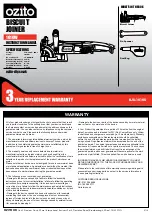
BISCUIT & JOINT GUIDE
8. BISCUIT SELECTION
9. TYPES OF JOINTS
Below is a table outlining the dimensions of the 3 common biscuits
sizes which your biscuit joiner has preset depths for on the depth
adjustment knob.
Edge to Edge Joint
Edge-to-edge joinery is one of the easiest joints to construct. It is
commonly used when making larger panels from smaller boards. One
such application is a table top.
Butt Joint
A butt joint is one of the weakest joints in woodworking. This type
of joint is mating the end grain of one board with the edge grain of
another. The bonding of glue on this type of surface is poor.
However, by using biscuits you can create a very strong joint that gives
a mortise-and-tenon effect.
T-joint
A T-joint is used when the end of a board is joined to the face of
another board. Typical applications for T-joints are attaching shelves to
bookcases, or inner support braces to frames. Actual cutting of a T-joint
is as simple as any other cut. However, it is critical that you mark the
centrelines, mark the intersection points for each slot and cut each slot
correctly.
Mitre Joint
Mitre joints provide a neat finish to a corner joint as they do not show
the end grain of the workpiece. Reinforcing the joint with the addition
of a biscuit is a great way to add strength. Mitre joints are used when
making boxes or drawers.
Corner Joint
Corner joints are used when making picture frames. Using biscuits for
corner joints makes assembly much simpler. Clamping of corner joints
can be difficult. The biscuit helps to hold the workpieces in place while
the glue cures to secure the join.
Always try to use the largest biscuit
that will fit. In most cases this will
be #20. Occasionally, when using
thin workpieces you will need to
scale down to a #0 or #10 biscuit.
Biscuits are typically 3.75mm thick
and made from compressed beech
wood shavings stamped out in an
oval pattern.
Glue is applied to the biscuit and the joint. The glue soaks into the
biscuit causing it to swell and tighten up in the joint. The expansion of
the biscuit adds strength to the joint.
Note:
Always refer to the glue manufacturer’s instructions regarding
setting times.
Storage
Store your biscuits in a clean dry container. They can absorb moisture
from the air and swell, rendering them useless.
Biscuit
Width
Length
#0
16mm
44mm
#10
19mm
54mm
#20
25mm
60mm
Edge to Edge Joint
Butt Joint
T-joint
Mitre Joint
Corner Joint
Edge to Edge Joint
Butt Joint
T-joint
Mitre Joint
Corner Joint
Edge to Edge Joint
Butt Joint
T-joint
Mitre Joint
Corner Joint
Edge to Edge Joint
Butt Joint
T-joint
Mitre Joint
Corner Joint
Edge to Edge Joint
Butt Joint
T-joint
Mitre Joint
Corner Joint










